How Can We Help?
Digital Assets
The module of digital assets covers Resources, Digital Twins, and BIM Data.
Directory management of digital assets
In the Digital Assets module, the directory is a key tool for managing digital twin assets and resources. The directory bar displays all the directories that users can access, making it convenient for users to manage digital twin assets, resources, etc.

The directory provides rich management functions:
-
- Create a new directory: Users can create new directories as needed and define who is visible to these directories.
- Delete directories: Users who possess deletion permission can delete customized public directories to better organize and manage digital assets.
- Directory sorting: Provides sorting functions by modification date, creation date, name, etc., supporting both ascending and descending order.
Directory type
The digital asset directory is divided into the following four types:
|
Type |
Description |
|
Department directory |
With the creation of departments, the system will automatically establish corresponding directories for the unified organization and management of departmental data and resources. Department directories will be automatically deleted when departments are deleted. |
|
User private directory |
Personal storage space, named “My Space”, accessible and viewable only by the user themselves. |
|
Public directories created by users |
They are established by users with the permission to create new primary directories and are suitable for resource sharing and collaboration. |
|
DLC resource directory |
Public Directory and its subdirectories store digital twin resources launched by DataMesh. In the Resources, the DLC resource directory contains DLC model resources; in the Digital Twins, the DLC resource directory contains digital twin templates, digital twins, scenes, and attribute groups. |
User permission
Explanation of permissions in the chart:
-
- ✅: Granted permission
- ❌: No permission
Department directory permission
|
Operation |
Regular User |
Administrator |
|
View directory |
✅ |
✅ |
|
Create subdirectories |
✅ |
✅ |
|
Resources management |
✅ (View, upload, download, edit, move) |
✅ (View, upload, download, edit, move) |
|
Create department directory |
❌ |
✅ (Automatically create via the creation of department) |
|
Delete department directory |
❌ |
✅ (Automatically delete via the deletion of department) |
DLC resource directory permission
|
Operation |
All users |
|
View directory and resources |
✅ |
|
Use resources (eg. Use models in the DLC to edit scenario) |
✅ |
|
Delete resources |
❌ |
|
Delete directories |
❌ |
User private directory permission
|
Operation |
Individual users |
|
View directory and resources |
✅ |
|
Create subdirectories |
✅ |
|
Manage resources |
✅ |
Permission for public directories created by users
|
Operation |
Creator |
Users visible to the directory |
Company administrator |
|
View directories |
✅ |
✅ |
✅ |
|
Edit visibility |
✅ |
❌ |
✅ |
|
Add subdirectories |
✅ |
✅ |
✅ |
|
Delete directories |
✅ |
❌ |
✅ |
|
Manage resources |
✅ |
✅ |
✅ |
Note: Deleting a directory will automatically delete its subdirectories.
Resources
The Resources includes documents, images, videos, audio files, models uploaded by users, as well as scenario files created by DataMesh Studio. Users can load and use files from the Resources in DataMesh client products.
You can select Digital Assets > Resources in the functional module navigation bar to enter the resources page. The resources page supports operations such as uploading and downloading resource files.

Below are the operation instructions for the Resources page:
-
- Upload resources: On the Resources page, you can click the upload button
 to upload your resource files. For more information about uploading resources, please refer to Upload Resources.
to upload your resource files. For more information about uploading resources, please refer to Upload Resources.
- Upload resources: On the Resources page, you can click the upload button
-
- Filter resources: Click
 to filter resources by tags and types.
to filter resources by tags and types.
-
- After selecting a tag, the resource list will display all resources with that tag.
- You can view resources by type, including scenario, model, and document.
-
- Resource search: You can use the search box to search for resources, and the search location option before the search box allows you to choose whether to conduct a global search or a search in the current directory.
- Resource operations: After selecting a resource file, you can choose to download, delete, or move the resource file. Note: When the user does not have operation permission, the operation option button is grayed out.
- Filter resources: Click

-
- View resource details: Click the resource details button
 to view resource file details.
to view resource file details. - Rename resource files: Click the resource’s edit button
 , you can rename the resource.
, you can rename the resource.
- View resource details: Click the resource details button
Upload resources
You can upload different types of files to the DataMesh FactVerse platform, each with its respective size limit.
|
File Type |
File Extension |
Size limit |
|
Document |
|
256MB |
|
Video |
.mp4, .mov |
256MB |
|
Audio |
.mp3, .ogg |
256MB |
|
Image |
.png, .jpg |
128MB |
|
3D model |
glb, fbx, 3mf, obj, ply, stl, rvt |
500MB |
|
Simulation data script file |
.iotsim |
128MB |
|
Customizable resources |
.zip |
128MB |
Upload customizable resources
Customizable resources include advanced resources, widgets, and personalized scenes, which usually require DataMesh to provide corresponding development support to achieve the desired customization functions and effects.
The ZIP file of customized resources needs to be uploaded to the FactVerse platform through DataMesh Importer, and the accelerated model files will be displayed as files with the extension “.dmasset”.
Upload documents, videos, audio, images, 3D models, data script files
Users can upload documents, videos, audio, pictures, 3D models, and data script files as needed.
Steps
The steps for uploading resources are as follows:
1. Select the directory where you want to store the resource on the Resources page, and then click the Upload button.

2. Click ![]() or drag files to the upload window. You can upload up to 10 files at a time.
or drag files to the upload window. You can upload up to 10 files at a time.

3. Click the Upload button to start uploading files.
4. Click the Upload details button on the top navigation bar to view upload details of the files.

If a file being uploaded has the same name as a file in the directory, it will result in an upload failure. You can rename the file in the Upload details window and then upload it again.

5. After finishing uploading the resource, the server will accelerate the model files except for .rvt files. The acceleration service is supported by Unity Accelerator. Company administrators can configure the acceleration platform on the Acceleration Service Settings module of Enterprise Settings.
The icon for “Accelerating” is ![]() , and the icon for “Acceleration completed” is
, and the icon for “Acceleration completed” is ![]() . Additionally, you can check the acceleration status information of models in the message center.
. Additionally, you can check the acceleration status information of models in the message center.
Manually accelerate model files
FactVerse offers model acceleration services that automatically optimize uploaded models to improve loading and rendering performance on various platforms. Additionally, users can manually trigger acceleration tasks by clicking the Refresh button on the acceleration status after the model upload is complete.

Manual acceleration tasks will enter the acceleration service’s queue. Since acceleration services are shared among multiple users, task completion time is influenced by the number of queued tasks and the size of the model.
If there are many queued tasks or the uploaded model is large, the acceleration task completion time may be longer. Conversely, if there are fewer queued tasks or the uploaded model is smaller, the acceleration task completion time may be faster.
Acceleration status is indicated by:
-
- Green dot: Acceleration successfully completed.
- Red dot: Acceleration failed.
- Black dot: Waiting for acceleration.
Import files from BIM 360
The DataMesh FactVerse platform supports importing files from Autodesk BIM 360.
Prerequisites
1. The enterprise administrator sends a developer invitation email to DataMesh.
2. DataMesh fills in Forge Client ID, App Name, App Logo, App description to obtain access permission to users’ Autodesk BIM 360 accounts.
Specific steps can be found in: Manage API Access to BIM 360 Docs | BIM 360 API | Autodesk Platform Services
Steps for importing files from BIM360:
1. Select the directory in the Resources page to store the resources, then click the Import from BIM 360 button.

2. In the Hub window, select the BIM360 account, then click Confirm.
3. In the Project window, select the project and click Confirm.
4. In the Folder window, select the folder, then click Confirm.
5. In the project window, select the .rvt file to upload, then click Confirm to complete the file import.
RVT file conversion
You can convert RVT files to FBX models on the DataMesh FactVerse platform. The converted files can be used directly as model resources in DataMesh Studio or FactVerse Designer. Note: To use the RVT file conversion function, the file conversion service needs to be activated in the enterprise’s subscribed license.
Specifications for the file format conversion feature:
-
- Supported file format: RVT files (Revit 2021 – Revit 2023).
- Conversion to: FBX files (3ds Max 2023).
- Reduction rate: 10%, 20%, 30%.
- File size: Currently we only support online conversion and processing of BIM models smaller than 100MB. For conversion and processing requirements of larger models, please contact clientcare@datamesh.com.
Steps
1. On the DataMesh FactVerse platform, go to Digital Assets > Resources page.
2. Click the Upload button to upload files or click the Import from BIM 360 button to import files from BIM 360.
3. Click the corresponding conversion icon ![]() for the RVT file to be converted.
for the RVT file to be converted.
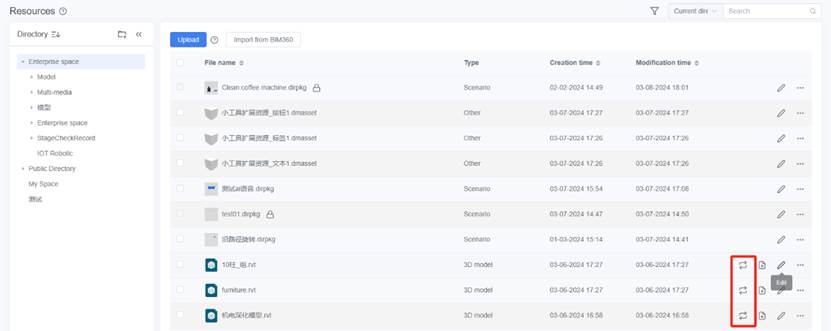
4. In the pop-up Model conversion window, select the Convert to, Polygon reduction rate, and Merge rules.

Convert to: FBX format
Polygon reduction rate: When converting RVT files to FBX format, you can choose an appropriate reduction rate according to specific needs to balance the quality and performance of the model. On the basis of maintaining the original model structure, reduce the total number of polygons of the converted model by the selected percentage to simplify the model, save space, and enhance performance when viewing in the architectural scene.
Merge rules: Use this drop-down list to choose the way in which Revit objects are combined. Combining objects can reduce the number of objects in your 3ds Max scene and improve performance. Merge rules include the following options:
-
- Do not combine components: Imports each Revit object as a single 3ds Max object.
- Combine by category: Revit objects in the same category become a single 3ds Max object. The object has the name of the category and is placed on a layer with the same name.
- Combine by family type: Revit objects belonging to the same Family Type become a single 3ds Max object. The object has the name of the family type and is placed on a layer with the same name.
- Combine by material: Revit objects with the same material specification are consolidated into a single 3ds Max object. This object shares the same name as the material and is placed on a layer with a matching name. Revit metadata (series and category) does not appear in the 3ds Max Scene Explorer, and multi-dimensional/sub-object material information is lost.
The choice of merging method depends on your application scenario and requirements. If you are concerned about material organization, you can choose “Combine by material.” If you need to retain the original structure and details of the RVT file, you can choose “Do not combine components.”
5. Click the Confirm button to start the conversion process.
When the conversion status of the file shows “Processing completed,” the file is processed into the corresponding format of the model file and stored in the same directory as the original RVT file.
Delete resources
You can delete one or more resource files at once. Here are the steps to delete a resource:
1. Select the directory where the resource is located on the Resources page, and then check the checkbox in front of the resource file you want to delete.
2. Click the delete button ![]() .
.
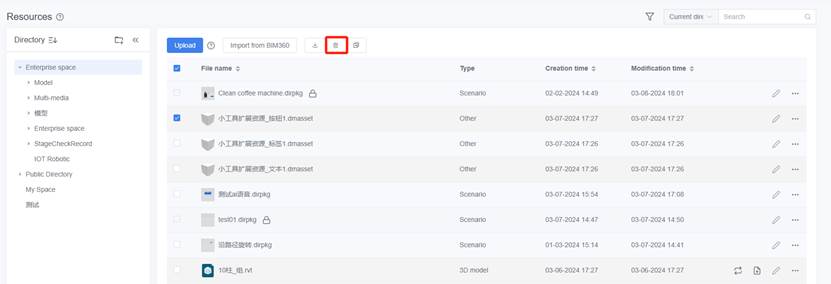
3. Click Confirm in the pop-up prompt window to complete the resource deletion.
Note: Deleted files cannot be recovered and will cause scenarios that use these files to be unable to play. Therefore, please make sure that you no longer need these resource files before deleting them.

Download resources
To download resources to your local device:
1. Select the directory where the resource is on the Resources page and check the checkbox in front of the resource file you want to download.
2. Click the Download button ![]() .
.

3. When the browser prompts you to download multiple files, you need to click Allow to complete the download of multiple resources.
Move resources
To move one or more resource files to another storage directory:
1. Select the directory where the resource is on the Resources page and check the checkbox in front of the resource file you want to move. If you want to move multiple files, you can select multiple checkboxes.
2. Click the Move button ![]() .
.

3. In the pop-up window for selecting the directory, select the target folder directory where you want to move the resource.
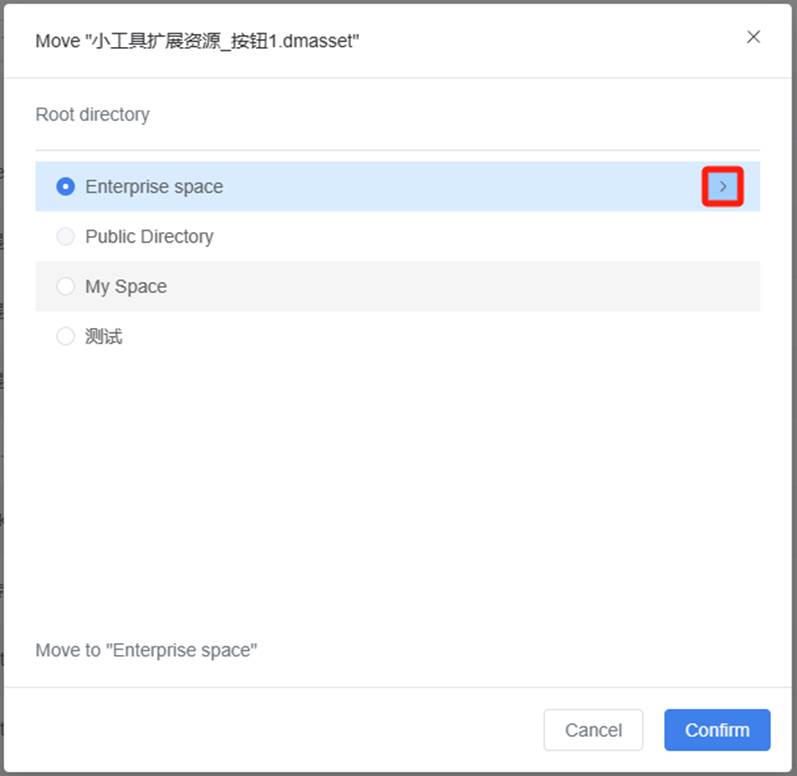
4. Click the Confirm button to confirm your selection, and the system will move the selected resource files to the target folder.
View resource details
Here are the specific steps:
1. Select the directory where the resource is located on the Resource page, and then click the details button ![]() of the resource file you want to view.
of the resource file you want to view.
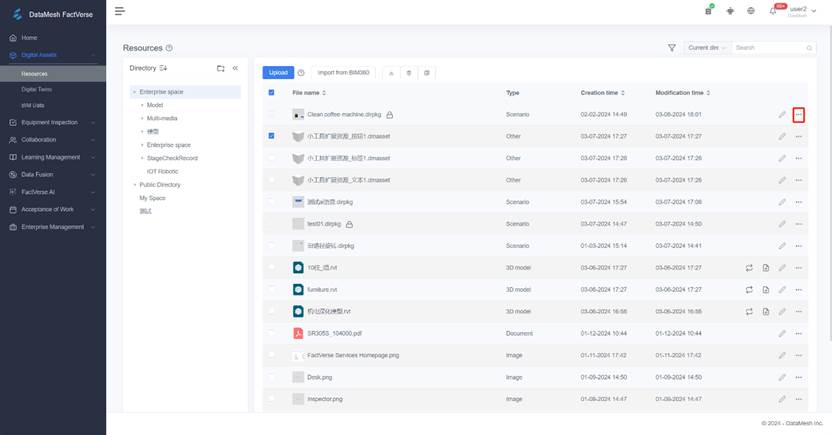
The details of this resource are shown in the following figure:

The Resource Details page displays the following information about the resource:
-
- File Name: Resource filename.
- Directory: Resource storage directory.
- Size: File size.
- Number of position QR codes: The number of position QR codes included in the scenario file.
- Creation time: Resource upload date.
- Modification time: Resource modification date.
- Creator: The username of the user who uploaded the resource.
- Accelerated State: When viewing the details of a model file, the Resource Details page displays the accelerated state information of the model, indicating the progress of utilizing acceleration services on various platforms. The states are as follows: Pending acceleration, Accelerating, Acceleration completed, Acceleration failed (in this state, manual re-acceleration is possible). Note: When manually accelerating, the resource’s acceleration task will enter the acceleration service queue because the service is shared with other users within the organization. The completion time of the acceleration task depends on the number of queued tasks and the size of the model.
- Tags: Tags are used for the classification of resources, events, and scene projects.
- Resource QR Code: Clicking on the thumbnail of the QR code in the upper right corner of the general information column opens the QR code for the resource. Users with access permission to the corresponding directory within the same tenant can scan this QR code using DataMesh One to quickly view and access the resource.

Rename resource files
To rename a resource file:
1. Select the directory where the resource is located on the Resources page.
2. Click the edit button ![]() of the resource.
of the resource.
3. Modify the resource name.

4. Click the Finish button ![]() to complete the resource renaming.
to complete the resource renaming.
Digital Twins
You can navigate to the Digital Assets > Digital Twins in the function module navigation bar to access the Digital Twins page.

On the Digital Twins page, users can create and manage digital twin templates, attribute groups, digital twins, resources, behavior trees, scenes, etc., to manage the digital twin content of the virtual world. This provides comprehensive support for enterprises, including training, guidance, experience, monitoring, control, simulation, and other functions.
Here are the operation instructions for the Digital Twins page:
- Create digital twin content: On the Digital Twins page, you can click the New button to create new templates, digital twins, scenes, or attribute groups.
- Filter digital twin content: Click the filter button
 to filter digital twin content by tags or types.
to filter digital twin content by tags or types.
-
- After selecting a tag, the resource list will display all digital twin content with that tag.
- After selecting a type you can view resources by type, including templates, digital twins, scenes, behavior trees, and attribute groups.
-
- Search: You can use the search box to search for digital twin content, and you can choose to perform a global search or a search within the current directory.
- Operations on digital twin content: After checking the checkbox in front of the digital twin content, you can choose to delete or move that digital twin content.
- View digital twin content details: Click the detail button
 of the digital twin content to view its details.
of the digital twin content to view its details.
Template
A digital twin template defines a category of digital twins, a template for describing a category of digital twins. Each template contains metadata, behavior trees, and models for a category of digital twins, supporting the creation of similar digital twins.
Create a new template
In the Digital Twins page, you can create a blank template to start defining your digital twin.
Here are the steps to create a new template:
1. Select the storage directory for the template on the Digital Twins page.
2. Click the New button.

3. In the New digital twin window, select the Template section.

4. In the New Template window, fill in the template information and click the Confirm button.

-
- Name (required): The name of the twin template. It must start with Chinese, Japanese, English, or numbers, and up to 30 characters.
- Tags: Users can customize tags for template classification.
- Description: Template description.
- Thumbnail: Template cover image.
View template details
To view the template details, follow these steps:
1. Select the storage directory for the template on the Digital Twins page.
2. Click the details button ![]() of the template to open the Template Details page.
of the template to open the Template Details page.
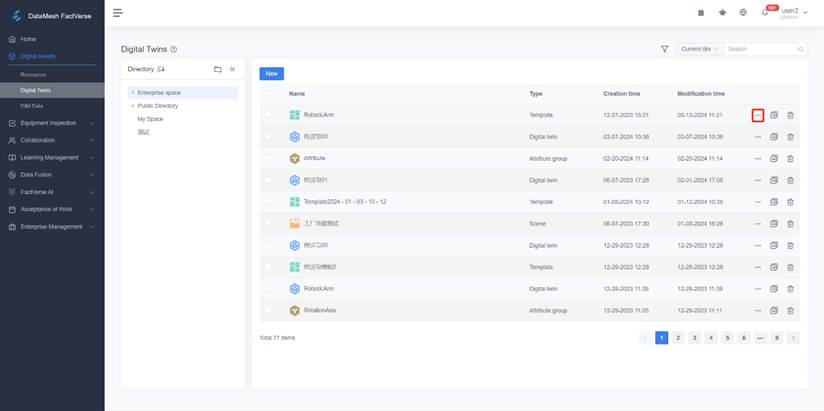
3. On the Template Details page, you can view the detailed information of the template, and add attribute groups, behavior trees, resources, sub-templates and the associated digital twins (i.e., digital twins created based on this template).

Add a private attribute group
In the Template Details page, you can add a private attribute group to a template to customize the template attributes.
Here are the steps:
1. Select the storage directory for the template on the Digital Twins page.
2. Click the detail button ![]() of the template you want to edit to enter the Template Details page.
of the template you want to edit to enter the Template Details page.
3. Click the New button under the attribute column.
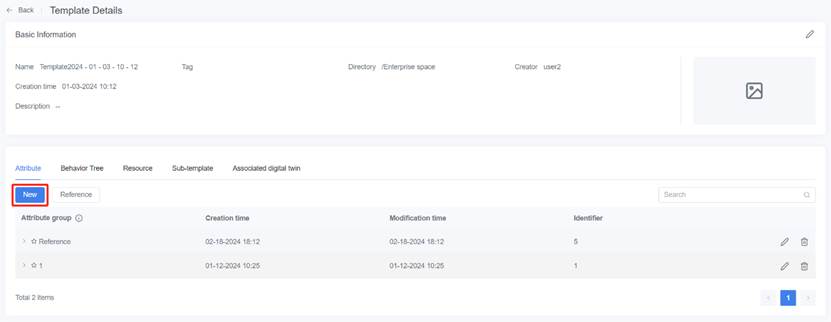
4. Fill in the Attribute Group Name (required) in the New Private Attribute Group window and click Confirm to display the new attribute group in the attribute column.
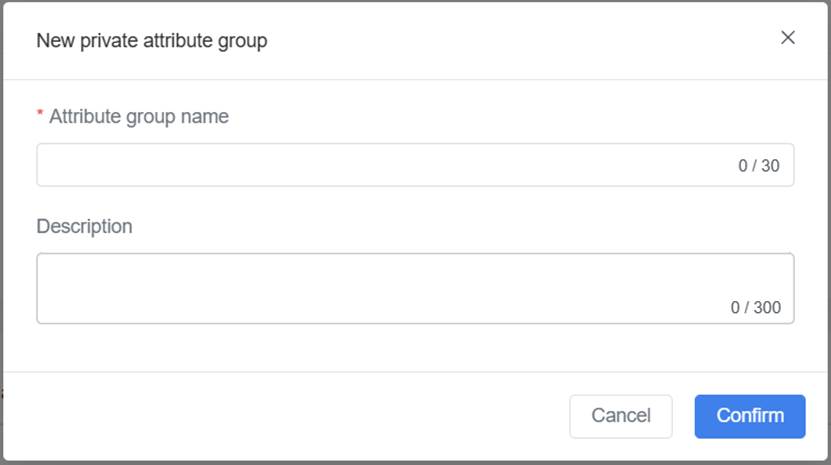
5. Click the add button ![]() of the attribute group.
of the attribute group.

6. Fill in the attribute information such as Name (required), Data Type, Value Range (required), and Step Size (required) in the New Attribute window.

Name: It must start with Chinese, Japanese, English, or numbers, and up to 30 characters.
Data Type: Please refer to the Data types of attributes.
7. Click Confirm to complete the creation of the attribute.
8. You can repeat Step 5 to Step 7 to create more attributes.
Reference the public attribute group
In the Template Details page, you can reference existing public attribute groups for a template. Please note the following:
1. Pre-create public attribute groups: Make sure that the public attribute groups you want to leverage have been created in advance, either by yourself or by other users. For more information on creating public attribute groups, please refer to Create a public attribute group.
2. Have access rights: Ensure that you have the necessary access rights to the directory where the attribute group belongs.
Here are the steps to leverage a public attribute group for a template:
1. Select the storage directory for the template on the Digital Twins page.
2. Click the detail button of the template you want to edit to enter the template details page.
3. Below the attribute column, click the Reference button.
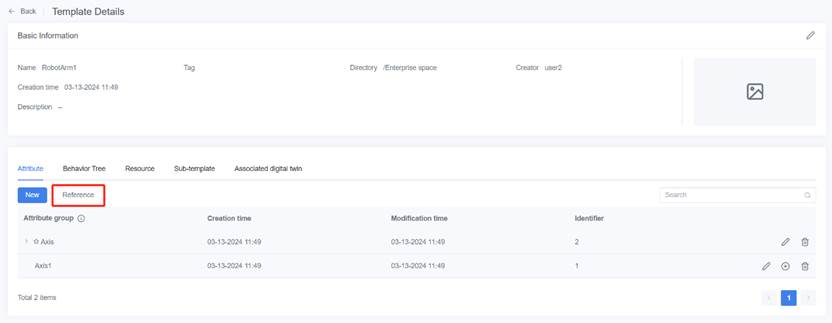
4. In the Reference window, fill in the Attribute Group Name, select the directory where the public attribute group to be referenced is located, and select the public attribute group in that directory. Note: A public attribute group has already been created before the operation.

5. Click Confirm, and the referenced attribute group (✩attribute group name) will be displayed in the attribute group list.
Add sub-templates
In the Template Details page, you have the option to add sub-templates to a template, which helps define a specific part of the template’s structure. For example, in a template for an autonomous vehicle, you can add a sub-template for tires to define the tire component of the vehicle.
Here are the steps to add a sub-template:
1. Select the storage directory for the template on the Digital Twins page.
2. Click the details button ![]() of the template you want to edit to enter the Template Details page.
of the template you want to edit to enter the Template Details page.
3. Below the Sub-template column, click the Select button.

4. In the Select window, select the desired sub-template.
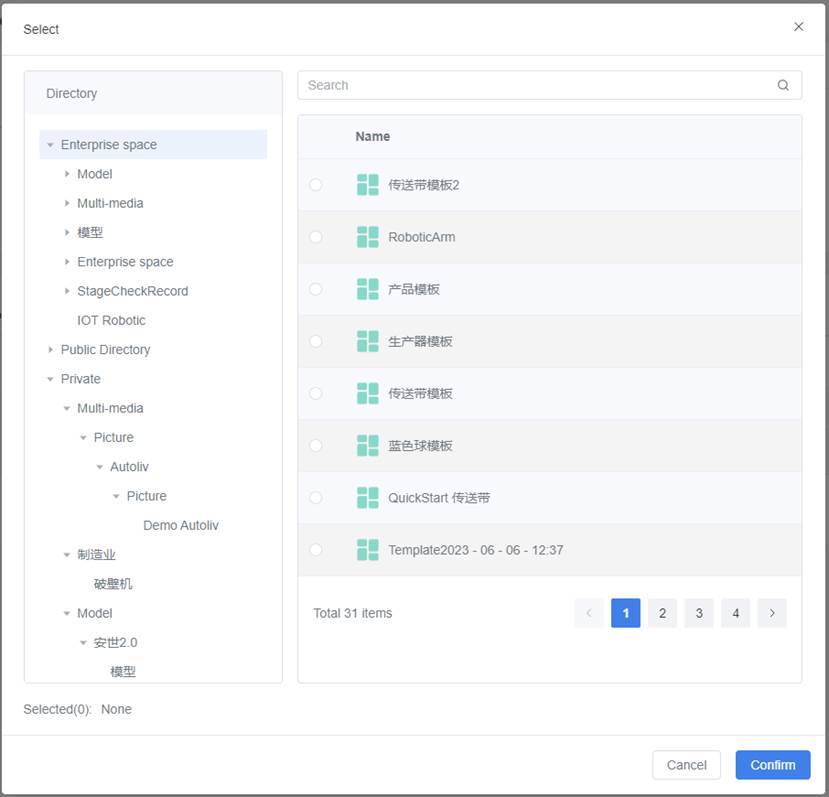
5. Click Confirm to complete the addition of the sub-template.
Delete a template
You can delete unnecessary templates by following these steps:
1. Select the storage directory for the template on the Digital Twins page.
2. Click the delete button ![]() of the template you want to delete.
of the template you want to delete.
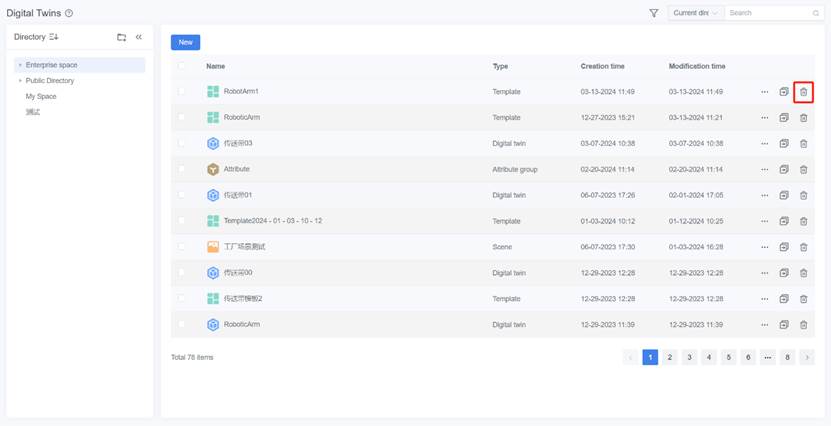
3. In the prompt window, click Confirm.

Attribute Groups
An attribute group is a collection of common attributes used to describe a digital twin, which usually correspond to the functionality, characteristics, or information of the digital twin.
You can manage public attribute groups in the Digital Twins page and reference these attribute groups in templates when needed to quickly add attribute groups and improve their reusability and maintainability.
Data types of attributes
Attributes are used to describe the properties or characteristics of a digital twin, which usually correspond to the functionality, characteristics, or information of the digital twin.
The following table shows the data types of attributes used in FactVerse:
|
Type |
Description |
Definable attributes |
|
Int |
Integer type, used to describe integer physical quantities, such as 1, 2, 5. • Value range: -2147483648 ~ 2147483647 • Step size: Add a specified value (i.e., step size) in each operation and repeat the operation. • Unit: the measurement unit of attribute data, such as meters, centimeters. |
Quantity, frequency, speed, etc. |
|
Double |
Describes physical quantities in floating-point format, with 8-byte precision, such as 1.2, 2.5, 3.0. It can be used to represent attributes that require precise numerical representation, such as “time”, “percentage”, and “exchange rate”. • Value range: -2147483648 ~ 2147483647 • Step size: Add a specified value (i.e., step size) in each operation and repeat the operation • The measurement unit of attribute data, in string type. For example, meters, centimeters. |
Temperature, humidity, power consumption, balance, mass, area, etc. |
|
String |
Also known as a text type, used to input text. • Data length: The default set value is 10240 bytes. |
ID, model, etc. |
|
Bool |
Also known as the Boolean type, it is a judgment type used for logical judgment. The value of a bool type attribute is either true (1) or false (0). |
Operational status, check status, execution results, etc. |
|
Vector3 |
Used to describe physical quantities of three-dimensional space information, such as coordinates, rotation angles, scaling, and other attributes. • Application: Position, rotation。 • Unit: The measurement unit of attribute data, in string type. For example, degrees, cm. • Attribute value: In the format of x, y, z. |
Placement position, placement angle, path positions, etc. |
|
Color |
• Attribute value: In the format of R, G, B, A, where the first three numbers represent RGB color values, and the fourth number represents the transparency value. • Value range: Each number is a decimal between 0-1. For example, 1.0, 1.0, 1.0, 1.0. |
Appearance colors, status colors, etc. |
|
Path |
Moving paths, transfer paths, transport paths, etc. |
|
|
Date |
Such as 2023-03-01 00:00:00. |
Production date, maintenance date, etc. |
|
Time |
Start time, landing time, stop time, etc. |
|
|
Enum |
Enumerated type, indicating the correspondence between identifiers and enumeration values. • Enumeration items: 1-100. • Attribute value: Supports integers. • Value range: -2147483648 ~ 2147483647. |
Error codes and error types, product codes and product categories, etc. |
Create a public attribute group
The following are the steps to create a new public attribute group:
1. On the Digital Twins page, select the directory for the attribute group.
2. Click the New button.

3. In the New digital twin window, click Attribute group section.

4. In the New public attribute groups window, enter the Attribute Group Name (required), and then click the Confirm button. The newly created attribute group will be displayed on the Digital Twins page.
Note: The attribute group name must start with Chinese, Japanese, English or numbers, and does not support special characters.
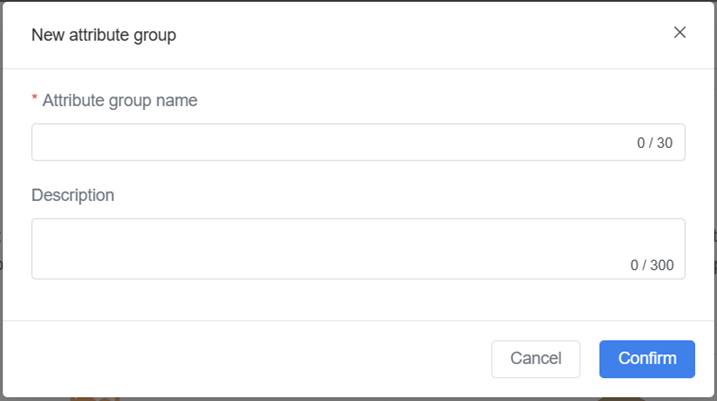
5. Click the details button ![]() of attribute group to open attribute group details page.
of attribute group to open attribute group details page.
6. Click the New button to add attributes for the attribute group.

7. In the New Attribute window, fill in the attribute information. For example, you can create an attribute for rotation angle:
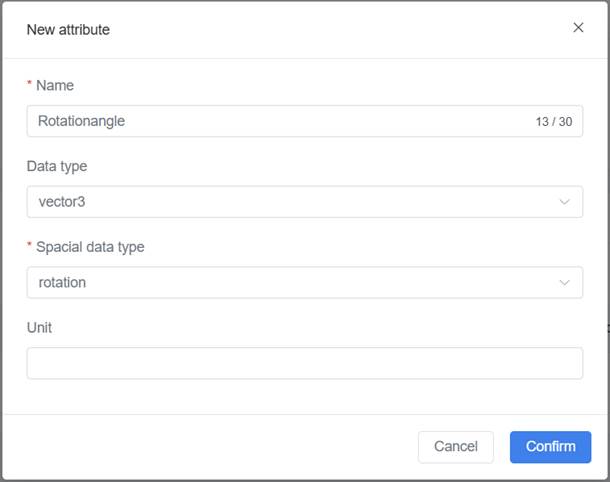
Name (required): must start with Chinese, Japanese, English or numbers, and not exceed 30 characters.
Data Type: please refer to Data types of attributes.
8. Click Confirm and the newly added attribute will be displayed in the attribute list of the Attribute group details page. You can click the delete button ![]() or edit button
or edit button ![]() to delete or edit the attributes as needed.
to delete or edit the attributes as needed.

9. You can repeat steps 6-8 to add multiple attributes to the attribute group.
By following the above steps, you can create a new public attribute group and add attributes to it. When creating a digital twin template, you can easily reference the public attribute group and use its attributes to describe the digital twin.
To delete a public attribute group, you can click the delete button ![]() for the attribute group and click Confirm in the prompt window to complete the deletion of the public attribute group.
for the attribute group and click Confirm in the prompt window to complete the deletion of the public attribute group.
To edit the name of a public attribute group, you can click the edit button ![]() for the attribute group on the attribute group details page, modify the Attribute group name in the Edit attribute group window, and then click Confirm to complete the editing of the attribute group name.
for the attribute group on the attribute group details page, modify the Attribute group name in the Edit attribute group window, and then click Confirm to complete the editing of the attribute group name.
Digital twin
A digital twin is an equivalent mapping of a physical entity in the digital world. Each digital twin is a specific instance of a digital twin template.
You can create, edit, delete, or view digital twins on the digital twins page.
Create a digital twin
Creating a digital twin means creating a digital twin based on a digital twin template, which can inherit metadata attributes, behavior trees, resources, sub-templates, and associated digital twins from the template.
Steps
1. Select the storage directory for the digital twin on the Digital Twin page.
2. Click the New button.
3. In the New digital twin window, select the digital twin section.

4. In the pop-up window, fill in the information for the digital twin.
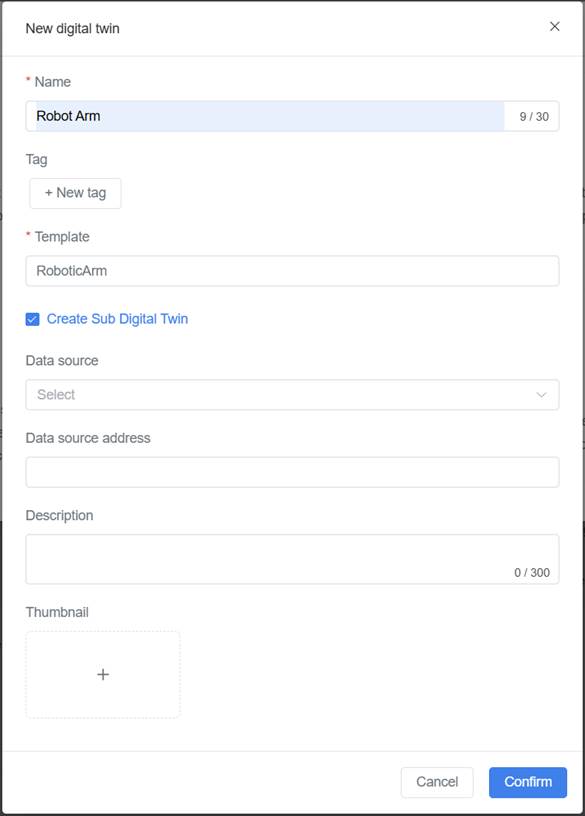
Name (required): The name of the digital twin.
Template (required): The digital twin template.
Create a Sub Digital Twin: When a template A contains a sub template B, if this configuration is selected when creating a digital twin using template A, the system will create two independent digital twins for template A and sub template B at the same time.
Data Source: The data source of the digital twin can be divided into three types: HTTP, HTTPS, and TCP.
Data Source Address: It can be a real data interface or a simulated data script.
-
- Real data interface: Fill in the IP address specified in the MQTT server access information.
- Simulated data script: The script needs to be uploaded to DataMesh FactVerse, and the storage path should be filled in the data source address. Format specification: SimulationFile:/storage path/filename.iotsim.
5. Click Confirm to complete the creation of the digital twin.
Behavior Tree
The behavior tree is a hierarchical node tree that controls the decision-making process of the digital twin, forming a series of decision logic to realize the operating mechanism of the digital twin. Note: you can create and edit the behavior tree in the FactVerse Designer and delete and move the behavior tree on FactVerse.
Scene
The Digital Twins page provides scene management functions that can be used in conjunction with FactVerse Designer.
The scene operation instructions are as follows:
-
- Create a new scene project: On the Digital Twins page, you can click the New button to create a new blank scene project. You can then open and edit the scene project using FactVerse Designer.
- Delete a scene project: Click the delete button corresponding to the scene project to delete it.
- View scene project details: Click the detail button corresponding to the scene project to open the Scene Details page and view the scene project details.
Creating a new scene
Steps
1. On the Digital Twins page, select the storage directory for the scene and click the New button.

2. In the New digital twin window, select the Scene section.

3. In the New Scene window, fill in the information for the scene project.
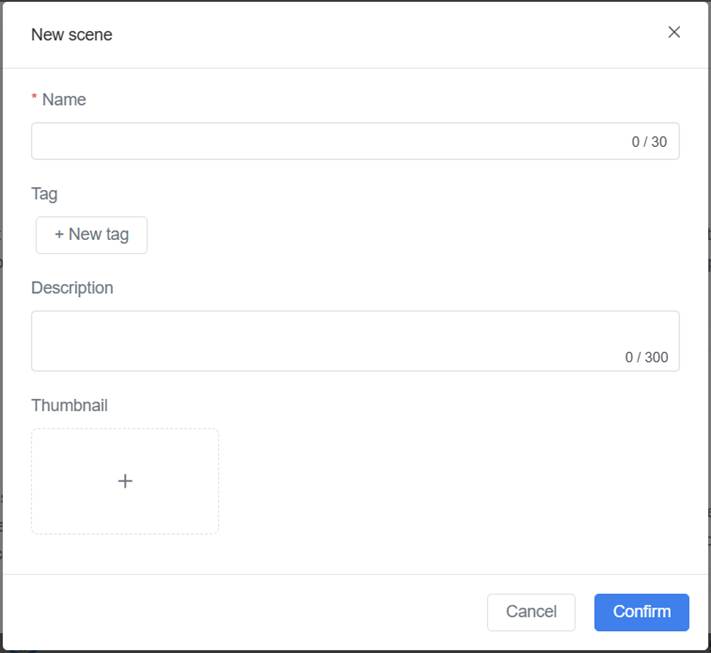
4. Click Confirm to complete the scene creation.
Viewing scene project details
On the Digital Twins page, click the detail button ![]() corresponding to the scene you want to view to open the Scene Details page.
corresponding to the scene you want to view to open the Scene Details page.
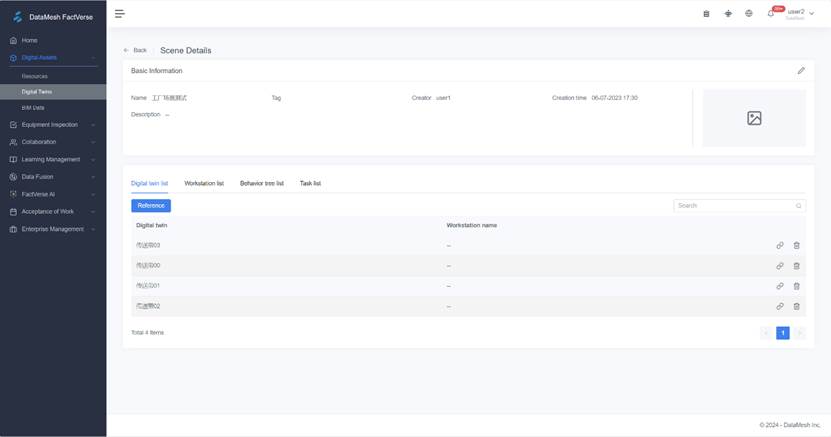
The Scene Details page displays basic information about the scene, including the scene name, tags, creator, creation time, and description. The bottom of the page includes the functions corresponding to the Digital twin list, Position list, Behavior tree list, and Task List.
Digital twin list

In the Digital twin list section on the Scene Details page, you can perform the following operations:
-
- Reference digital twins: You can click the Reference button to reference a digital twin.
- Delete digital twins’ reference: To remove the reference to a digital twin from the scene project, click the Delete button
 corresponding to the digital twin.
corresponding to the digital twin. - Assign workstation to a referenced digital twin: Click the Assign Workstation button
 corresponding to the digital twin to select a pre-built workstation for that digital twin. A digital twin can be bound to one workstation.
corresponding to the digital twin to select a pre-built workstation for that digital twin. A digital twin can be bound to one workstation.
BIM Data
The BIM Data service mainly supports the use of DataMesh Inspector. Through BIM Data service, users can create, manage, and browse architectural scene projects, and view and manipulate them in DataMesh Inspector.
To access BIM data, select Digital Assets in the function module navigation bar, then click on BIM Data, and you will enter the BIM Data page. This page shows a list of all architectural scene projects created and publicly displayed under the current directory. You can create new projects, delete and search for building scenes, and view detailed information about them.
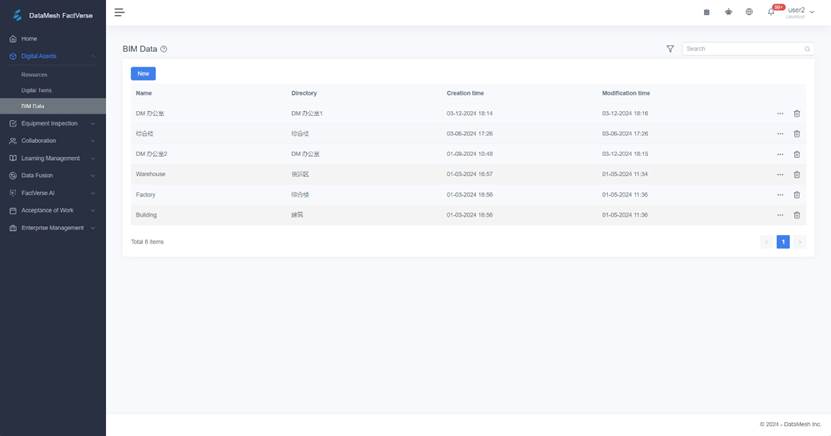
Create new architectural scenes
Create new architectural scenes:
1. Log into the DataMesh FactVerse platform. In the function module navigation bar, select Digital Assets > BIM Data to enter the BIM Data page.
2. On the BIM Data page, click the New button to open the New window.

In the New window, you need to fill in the following information about the architectural scene:
-
- Name (required): The name of the architectural scene.
- Directory (required): The storage directory of the architectural scene.
- Description: You can add some text to describe or characterize the architectural scene.
- Cover: You can select a standard format image from your local device as the cover of the scene. Choosing the right cover image can enhance the recognizability of the architectural scene.
3. After filling in the architectural scene information, click the Confirm button.
Import scene resources
Scene resources are model resources that constitute scenes, namely RVT files or zip files generated after processing RVT files (including component FBX files and Excel files containing component position rotation information and BIM information).
Note: Before importing scene resources, ensure that you have created the target architectural scene to correctly associate resources with the corresponding scene.
In the DataMesh FactVerse platform, you can import scene resources in two ways:
Method 1: Directly importing architectural scenes from resources
1. In the function module navigation bar, select Digital Assets, then click on Resources to enter the Resources page.
2. On the Resources page, click the import button ![]() corresponding to the RVT file you want to import to open the Import into the architectural scene window.
corresponding to the RVT file you want to import to open the Import into the architectural scene window.

3. In the Import into the architectural scene window, select the architectural scene to import to, then click the Confirm button.

4. In the function module navigation bar, select Digital Assets > BIM Data to enter the BIM data page.
5. Click on the details button ![]() corresponding to the architectural scene to enter the Architectural Scene Details page.
corresponding to the architectural scene to enter the Architectural Scene Details page.

6. On the Architectural Scene Details page, check the latest status of the file. When the file upload is complete, the file status changes from “Local uploading” to “Pending processing.”
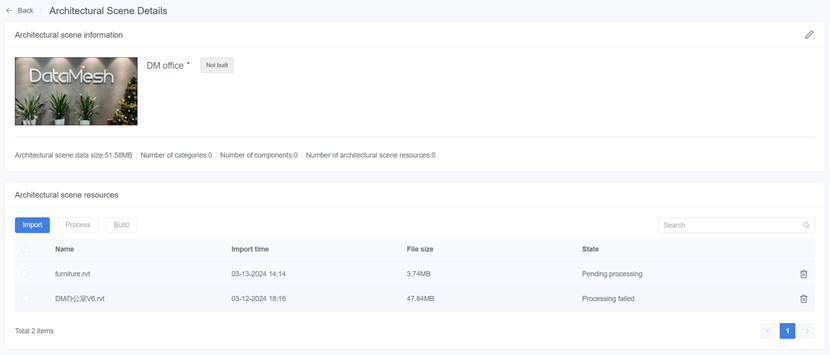
Method 2: Importing resources from the architectural scene details page
1. In the architectural scene details page, click the Import button to open the Select resource window.
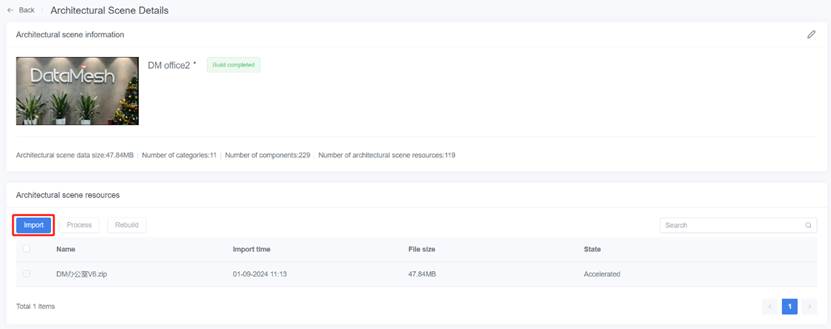
2. In the Select resource window, choose the required resource (RVT file or zip format file containing component FBX files and related information), then click the Confirm button to import the resource to the architectural scene.
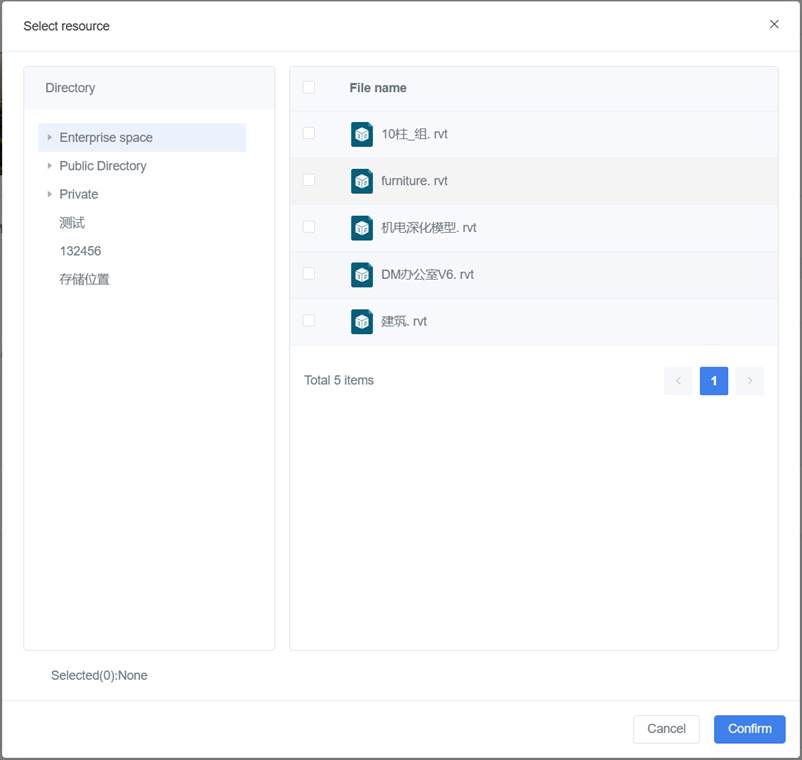
3. Refresh the page and check the latest status of the file. When the file status changes from “Local uploading” to “Pending processing,” it indicates that the file has been successfully uploaded.
Through the above methods, you can successfully import scene resources into the specified architectural scene. Please ensure the correct format of the resource files.
Process scene resources
The process of processing scene resources mainly involves format conversion and model building:
-
- Format conversion: You need to convert the imported Revit (.rvt) file into a format suitable for DataMesh Inspector at first, which is a zip file containing component FBX files and zip files containing component position, rotation information, and BIM information.
The specifications of the file format conversion function are as follows:
-
-
- Supported file format: RVT files (Revit 2021 – Revit 2023).
- Converted to: FBX files.
- Average conversion time:
- 1-200M: Within 3 minutes.
- 200M-500M: Within 5 minutes.
- 500M-1G: Within 10 minutes.
- 1G-3G: Within 30 minutes.
-
To convert RVT files to zip files, you can follow these steps:
a). On the Architectural Scene Details page, select the RVT file to be processed (the file status is “Pending processing”).
b). Click the Process button and confirm in the prompt box for file processing instruction to start the format conversion.

The processing time may vary depending on the file size. When the file status displays “processing completed,” it indicates that the scene resource format conversion has been completed.
2. Model building: Once the scene resources are converted to a format suitable for DataMesh Inspector, the next step is to accelerate the model. This process mainly optimizes the model data in the scene, and the accelerated files (usually 3D models) have faster loading speeds to ensure smooth display of large-scale spatial scenes on mobile devices.
a). On the Architectural Scene Details page, select the model (zip) file to be built, you can choose one or more, then click the “Rebuild” button to accelerate the file.

b). Refresh the page and check the latest status of the file. When the acceleration process is completed, the status will display as “Accelerated.”
After completing these processing steps, you can use DataMesh Inspector to open this architectural scene.